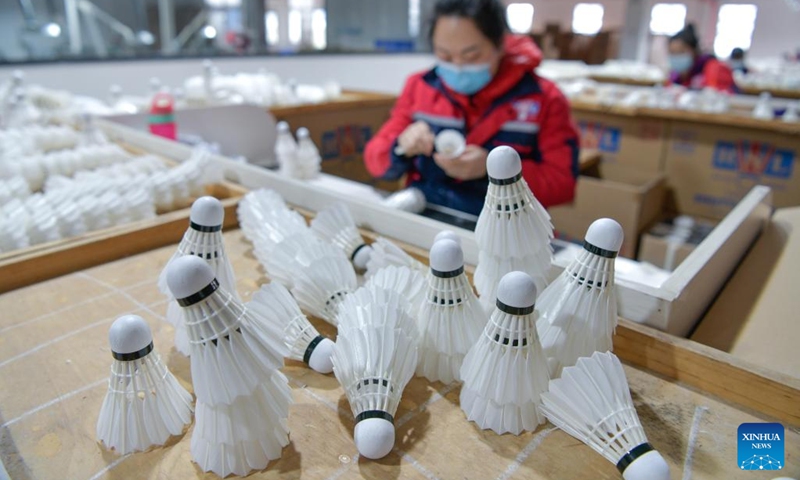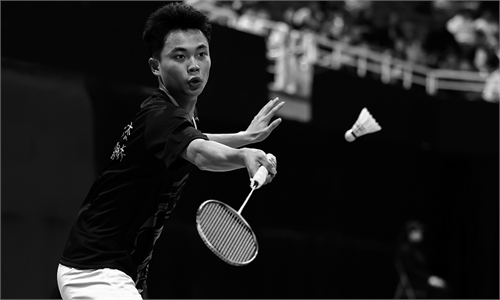
A worker checks products at a badminton shuttlecock enterprise in Jinping County in Qiandongnan Miao and Dong Autonomous Prefecture, southwest China's Guizhou Province, Dec. 19, 2022. (Photo: Xinhua)
Recently, the topic "badminton becomes the top sport among state-owned enterprises (SOEs) in China" has trended on social media, sparking lively discussions. Nearly every SOE now has badminton courts, with companies offering free court time and professional coaching for its employees. Badminton allows workers to play together during their off-hours, breaking the formal work environment and promoting communication with leaders through the sport.
In reality, badminton has long been a national sport in China. According to the 2023 National Fitness Status Report released by the General Administration of Sports of China, badminton is the most participated sport in China, counting 250 million amateur players. On top of that, badminton accounts for 6.9 percent of the fitness activities practiced by the public.
The popularity of the sport has led to increasing difficulty in booking badminton courts and rising costs, including a year-on-year rise in the price of badminton equipment. Some netizens joke that even a monthly salary of 20,000 yuan ($2,740) is no longer enough to afford playing the sport regularly. The arrival of summer vacation has exacerbated the situation with students adding to the number of players, making it even harder to secure court time.
A sport gone wild
By 6 am, the WeChat group for morning badminton enthusiasts is already alive with activity. Players swiftly form teams of six and register through group leader Xu to secure coveted court time, a routine that has become an integral part of Beijing's badminton culture.
As the popularity of badminton continues to soar, court availability has become a major challenge. Xu, manager of Huabao Badminton Court in Beijing, revealed to Global Times that reservations are fully booked until September. Individual players can only snag a spot between 6 am and 8 am, and even then, they must share the court with five to seven other players. During the summer months, the courts are completely taken over by youth training programs, further fueling the demand for this sport.
This phenomenon is not isolated. In Shanghai's Yuanshen Sports Center, which has five badminton courts, early morning slots are quickly filled even on weekdays. In Chengdu, capital of Southwest China’s Sichuan Province, popular afternoon slots at some badminton venues require booking 3-5 days in advance.
With the scarcity of courts, prices have also risen. Some badminton courts in Beijing now charge over 220 yuan per hour. With the arrival of summer vacation, badminton training classes are monopolizing court time, and the "scalping" of court bookings has started to emerge. Some management departments are working to optimize management by reducing educational training sessions and cracking down on scalping to ensure players can access badminton. Many places are also increasing the number of courts. Badminton coach Liang from Chengdu reflected that in his region, badminton venues have expanded from one to four in three years.
It's not just the venues that are in short supply. With the rising enthusiasm for badminton nationwide, the price of badminton equipment has also started to increase. According to China News Weekly, Zhang, the sales director of a sports goods company in East China’s Zhejiang Province, revealed that shuttlecock prices have undergone multiple rounds of increases, driven by the sport's booming popularity and supply-demand imbalance.
Official data shows that South China's Guangdong Province, a badminton stronghold, counts 15 million badminton enthusiasts, with 3 million in the city of Guangzhou alone. According to the Chengdu Badminton Association, more than 500,000 people in Chengdu play badminton on a regular basis, and the city offers over 440 venues with four or more badminton courts. JD.com staff revealed that during the June 18 shopping festival, the transaction volume of badminton rackets increased by over 50 percent year-on-year, with high-end rackets seeing a growth of more than 100 percent, according to China News Weekly.
The widespread enthusiasm for badminton has gone wild.
A sport for all ages
The immense popularity of badminton is no coincidence. A 2019 study published in The Lancet, which involved 1.2 million people, found that racket sports and aerobic exercises, including badminton, offer the greatest benefits for both physical and mental health, including a 47 percent reduction in overall mortality rates.
Luo Chaofan, a sports rehabilitation specialist from the Guangdong Provincial Health Commission, told the Global Times that badminton’s easy-to-learn nature and suitability for all ages are key reasons for its wide popularity.
"Compared with basketball, badminton is easier to pick up, and people of all ages can play. It also doesn't involve as many rapid stops or large movements, making it less intense," Luo said.
Huang Hongjie, an associate researcher and assistant physician at Peking University Third Hospital's sports medicine department, said that badminton requires relatively less specialized equipment when compared with soccer, basketball, or even table tennis. "Badminton also lacks physical confrontation, making it a safer sport," Huang said.
The social aspect of badminton also contributes to its appeal. Many people organize matches with friends or join badminton clubs to book courts. Some even look for badminton "partners" through social networks and badminton coaching has become increasingly popular among various age groups and skill levels.
Liang, who works part-time as a badminton coach, told the Global Times that his playing partners and students come from all age groups and skill levels.
"From children to the elderly to working professionals, everyone is squeezing in time to play badminton. Many of them come from completely different industries, but especially when playing in doubles, people gradually get to know each other. The badminton court has truly become a social venue," Liang said.
Guo, a patient in Shanghai's Jing'an District, recently recovered from a serious illness. She joined a badminton group in her community to improve her health and ended up making many new friends.
"I initially joined the badminton group to recover through exercise, but I didn't expect to meet so many new friends. Now I'm a badminton enthusiast, organizing games and even trips with the group," she said.
While badminton is suitable for all ages, experts also advise caution. "If you experience significant shoulder pain and swelling after playing, you should stop. Overuse of the shoulder can cause wear and tear on the rotator cuff and humeral head. Moderate exercise is enough to strengthen the body and improve mood," Huang warned.



